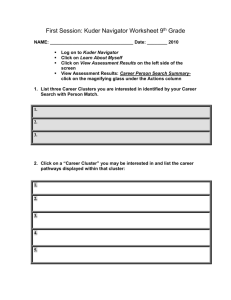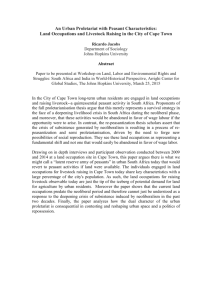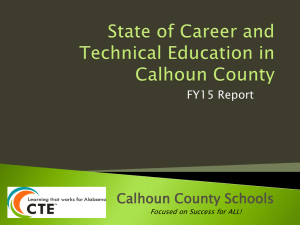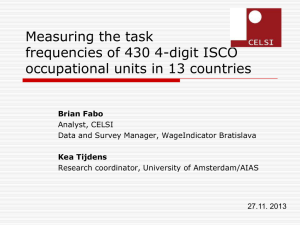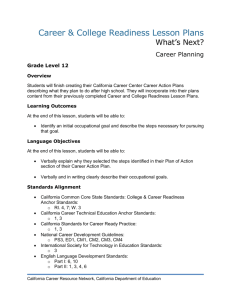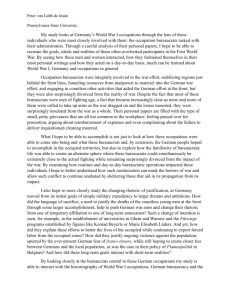File
advertisement
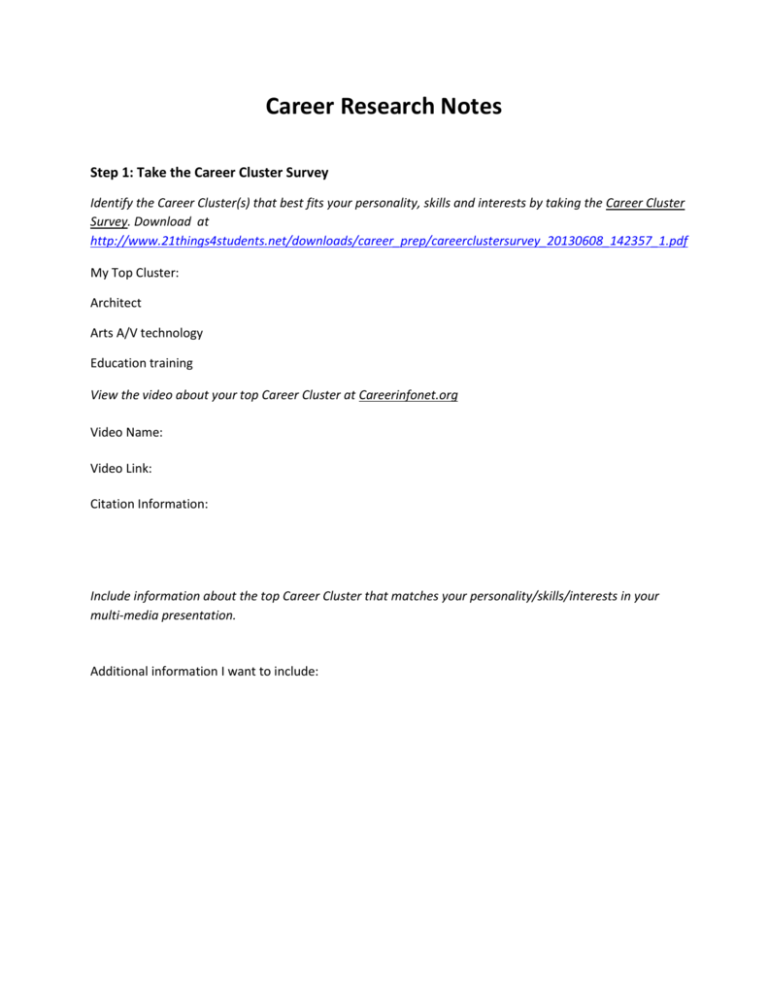
Career Research Notes Step 1: Take the Career Cluster Survey Identify the Career Cluster(s) that best fits your personality, skills and interests by taking the Career Cluster Survey. Download at http://www.21things4students.net/downloads/career_prep/careerclustersurvey_20130608_142357_1.pdf My Top Cluster: Architect Arts A/V technology Education training View the video about your top Career Cluster at Careerinfonet.org Video Name: Video Link: Citation Information: Include information about the top Career Cluster that matches your personality/skills/interests in your multi-media presentation. Additional information I want to include: Step 2: Research your Career Cluster Visit the CareerShip site at http://mappingyourfuture.org/planyourcareer/careership/index.cfm and search by Career Cluster (using results from your survey above). Locate three possible careers within your cluster, including details about career descriptions, tasks, interests, education, knowledge, skills, and etc. for use in your multi-media presentation. Category Career Description Tasks Career 1 Prepare drawings and topographical and relief maps used in civil engineering projects, such as highways, bridges, pipelines, flood control projects, and water and sewerage control systems. Produce drawings using computerassisted drafting systems (CAD) or drafting machines, or by hand using compasses, dividers, protractors, triangles and other drafting devices. Draft plans and detailed drawings for structures, installations, and construction projects such as highways, sewage disposal systems, and dikes, working from sketches or notes. Draw maps, diagrams, and profiles, using cross-sections and surveys, to represent elevations, topographical contours, subsurface formations and structures. Correlate, interpret, and modify data obtained from topographical surveys, well logs, and geophysical prospecting reports. Finish and duplicate drawings and documentation packages, according to required mediums and specifications for reproduction using blueprinting, photography, or other duplicating methods. Review rough sketches, drawings, Career 2 Not listed There is no information about specific tasks and the most important work generalized activities. This may occur because data has not been collected or because this is a composite occupation (e.g., "All Other"). Career 3 Teach courses in drama, music, and the arts including fine and applied art, such as painting and sculpture, or design and crafts. Evaluate and grade students' class work, performances, projects, assignments, and papers. Explain and demonstrate artistic techniques. Prepare students for performances, exams, or assessments. Prepare and deliver lectures to undergraduate and/or graduate students on topics such as acting techniques, fundamentals of music, and art history. Organize performance groups, and direct their rehearsals. Prepare course materials such as syllabi, homework assignments, and handouts. Initiate, facilitate, and moderate classroom discussions. Keep abreast of developments in their field by reading current literature, talking with colleagues, and participating in professional conferences. Advise students on academic and vocational curricula, and on career specifications, and other engineering data received from civil engineers to ensure that they conform to design concepts. Supervise and train other technologists, technicians and drafters. Supervise or conduct field surveys, inspections or technical investigations to obtain data required to revise construction drawings. Determine the order of work and method of presentation, such as orthographic or isometric drawing. Calculate excavation tonnage and prepare graphs and fill-hauling diagrams for use in earth-moving operations. Explain drawings to production or construction teams and provide adjustments as necessary. Locate and identify symbols located on topographical surveys to denote geological and geophysical formations or oil field installations. Calculate weights, volumes, and stress factors and their implications for technical aspects of designs. Determine quality, cost, strength and quantity of required materials, and enter figures on materials lists. Plot characteristics of boreholes for oil and gas wells from photographic subsurface survey recordings and other data, representing depth, degree and direction of inclination. issues. Maintain student attendance records, grades, and other required records. Conduct research in a particular field of knowledge, and publish findings in professional journals, books, and/or electronic media. Supervise undergraduate and/or graduate teaching, internship, and research work. Plan, evaluate, and revise curricula, course content, and course materials and methods of instruction. Maintain regularly scheduled office hours in order to advise and assist students. Compile, administer, and grade examinations, or assign this work to others. Participate in student recruitment, registration, and placement activities. Select and obtain materials and supplies such as textbooks and performance pieces. Collaborate with colleagues to address teaching and research issues. Serve on academic or administrative committees that deal with institutional policies, departmental matters, and academic issues. Participate in campus and community events. Keep students informed of community events such as plays and concerts. Compile bibliographies of specialized materials for outside reading assignments. Display students' work in schools, galleries, and exhibitions. Perform administrative duties such as serving as department head. Act as advisers to student organizations. Write grant proposals to procure external research funding. Provide professional consulting services to government and/or industry. Interests Education Realistic - Realistic occupations frequently involve work activities that include practical, hands-on problems and solutions. They often deal with plants, animals, and realworld materials like wood, tools, and machinery. Many of the occupations require working outside, and do not involve a lot of paperwork or working closely with others. Investigative - Investigative occupations frequently involve working with ideas, and require an extensive amount of thinking. These occupations can involve searching for facts and figuring out problems mentally. Artistic - Artistic occupations frequently involve working with forms, designs and patterns. They often require self-expression and the work can be done without following a clear set of rules. Conventional - Conventional occupations frequently involve following set procedures and routines. These occupations can include working with data and details more than with ideas. Usually there is a clear line of authority to follow. Education - Most occupations in this zone require training in vocational schools, related on-the-job experience, or an associate's degree. Training - Employees in these occupations usually need one or two years of training involving both onthe-job experience and informal training with experienced workers. Investigative - Investigative occupations frequently involve working with ideas, and require an extensive amount of thinking. These occupations can involve searching for facts and figuring out problems mentally. Artistic - Artistic occupations frequently involve working with forms, designs and patterns. They often require selfexpression and the work can be done without following a clear set of rules. Social - Social occupations frequently involve working with, communicating with, and teaching people. These occupations often involve helping or providing service to others. Education - Most of these occupations require graduate school. For example, they may require a master's degree, and some require a Ph.D., M.D., or J.D. (law degree). Training - Employees may need some on-the-job training, but most of these occupations assume that the person will already have the required skills, knowledge, work-related experience, Not listed Occupation: Artists and Related Workers, All Other Typical education needed for entry: High school diploma or equivalent A recognized apprenticeship program may be associated with these occupations. Knowledge Experience - Previous work-related skill, knowledge, or experience is required for these occupations. For example, an electrician must have completed three or four years of apprenticeship or several years of vocational training, and often must have passed a licensing exam, in order to perform the job. Customer and Personal Service Knowledge of principles and processes for providing customer and personal services. This includes customer needs assessment, meeting quality standards for services, and evaluation of customer satisfaction. Production and Processing Knowledge of raw materials, production processes, quality control, costs, and other techniques for maximizing the effective manufacture and distribution of goods. Physics - Knowledge and prediction of physical principles, laws, their interrelationships, and applications to understanding fluid, material, and atmospheric dynamics, and mechanical, electrical, atomic and sub- atomic structures and processes. Education and Training - Knowledge of principles and methods for curriculum and training design, teaching and instruction for individuals and groups, and the measurement of training effects. Public Safety and Security Knowledge of relevant equipment, policies, procedures, and strategies to promote effective local, state, or national security operations for the protection of people, data, property, Typical work experience needed for a job and/or training. Experience - Extensive skill, knowledge, and experience are needed for these occupations. Many require more than five years of experience. For example, surgeons must complete four years of college and an additional five to seven years of specialized medical training to be able to do their job. Clerical - Knowledge of administrative and clerical procedures and systems such as word processing, managing files and records, stenography and transcription, designing forms, and other office procedures and terminology. Personnel and Human Resources Knowledge of principles and procedures for personnel recruitment, selection, training, compensation and benefits, labor relations and negotiation, and personnel information systems. Therapy and Counseling - Knowledge of principles, methods, and procedures for diagnosis, treatment, and rehabilitation of physical and mental dysfunctions, and for career counseling and guidance. in this occupation: None Typical on-the-job training once you have a job in this occupation: Long-term on-the-job training There is no information about knowledge, skills and abilities. This may occur because data has not been collected or because this is a composite occupation (e.g., "All Other"). Foreign Language - Knowledge of the structure and content of a foreign (nonEnglish) language including the meaning and spelling of words, rules of composition and grammar, and pronunciation. Computers and Electronics - Knowledge of circuit boards, processors, chips, electronic equipment, and computer hardware and software, including applications and programming. Psychology - Knowledge of human behavior and performance; individual differences in ability, personality, and interests; learning and motivation; psychological research methods; and and institutions. Clerical - Knowledge of administrative and clerical procedures and systems such as word processing, managing files and records, stenography and transcription, designing forms, and other office procedures and terminology. English Language - Knowledge of the structure and content of the English language including the meaning and spelling of words, rules of composition, and grammar. Geography - Knowledge of principles and methods for describing the features of land, sea, and air masses, including their physical characteristics, locations, interrelationships, and distribution of plant, animal, and human life. Building and Construction Knowledge of materials, methods, and the tools involved in the construction or repair of houses, buildings, or other structures such as highways and roads. Computers and Electronics Knowledge of circuit boards, processors, chips, electronic equipment, and computer hardware and software, including applications and programming. Engineering and Technology Knowledge of the practical application of engineering science and technology. This includes applying principles, techniques, procedures, and equipment to the design and production of various goods and services. Mathematics - Knowledge of arithmetic, algebra, geometry, calculus, statistics, and their applications. Design - Knowledge of design techniques, tools, and principles involved in production of precision technical plans, blueprints, the assessment and treatment of behavioral and affective disorders. Sociology and Anthropology Knowledge of group behavior and dynamics, societal trends and influences, human migrations, ethnicity, cultures and their history and origins. History and Archeology - Knowledge of historical events and their causes, indicators, and effects on civilizations and cultures. Philosophy and Theology - Knowledge of different philosophical systems and religions. This includes their basic principles, values, ethics, ways of thinking, customs, practices, and their impact on human culture. Communications and Media Knowledge of media production, communication, and dissemination techniques and methods. This includes alternative ways to inform and entertain via written, oral, and visual media. Administration and Management Knowledge of business and management principles involved in strategic planning, resource allocation, human resources modeling, leadership technique, production methods, and coordination of people and resources. Education and Training - Knowledge of principles and methods for curriculum and training design, teaching and instruction for individuals and groups, and the measurement of training effects. English Language - Knowledge of the structure and content of the English language including the meaning and spelling of words, rules of composition, and grammar. Fine Arts - Knowledge of the theory and techniques required to compose, produce, and perform works of music, dance, visual arts, drama, and sculpture. drawings, and models. Skills Architectural Drafters Surveying Technicians Civil Engineering Technicians Electronic Drafters Fabric and Apparel Patternmakers Mechanical Drafters There is no information about knowledge, skills and abilities. This may occur because data has not been collected or because this is a composite occupation (e.g., "All Other"). Reading Comprehension Understanding written sentences and paragraphs in work related documents. Active Listening - Giving full attention to what other people are saying, taking time to understand the points being made, asking questions as appropriate, and not interrupting at inappropriate times. Numerical Tool and Process Control Programmers Traffic Technicians Writing - Communicating effectively in writing as appropriate for the needs of the audience. Speaking - Talking to others to convey information effectively. Critical Thinking - Using logic and reasoning to identify the strengths and weaknesses of alternative solutions, conclusions or approaches to problems. Learning Strategies - Selecting and using training/instructional methods and procedures appropriate for the situation when learning or teaching new things. Monitoring - Monitoring/Assessing performance of yourself, other individuals, or organizations to make improvements or take corrective action. Instructing - Teaching others how to do something. Other:___________ Step 3: Research Career Outlook Locate the nature of work, working conditions, education, job outlook, and earnings for your top three careers using the U.S. Bureau of Labor Statistics Occupational Outlook Handbook at http://www.bls.gov/ooh/ and/or the O*NET Database at http://www.onetonline.org/ Category Nature of Work Career 1 Career 2 Career 3 Architects held about The median annual wage for multimedia artists Archivists, curators, museum technicians, and 107,400 jobs in 2012, and animators was $61,370 in May 2012. The conservators held about 29,300 jobs in 2012. with two-thirds employed median wage is the wage at which half the in the architectural, workers in an occupation earned more than that engineering, and related amount and half earned less. The lowest 10 services industry. About 1 percent earned less than $34,860, and the top 10 in 5 were self-employed. percent earned more than $113,470. Architects spend much of In May 2012, the median annual wages for their time in offices, multimedia artists and animators in the top four where they meet with industries in which these artists and animators clients, develop reports worked were as follows: engineers. They also visit curators, museum technicians, and conservators in 2012 were as follows: Museums, historical sites, and similar institutions and drawings, and work with other architects and The industries that employed the most archivists, Motion picture and video industries $72,680 38% Government 26 Educational services; state, local, and private 18 construction sites to ensure the client’s Software publishers 62,310 Archivists work in museums, government, colleges and universities, corporations, and other objectives are met and to review the progress of projects. Some architects Advertising, public relations, and related services institutions that require experts to preserve important records. 60,220 work from home offices. Because most curators work at museums, zoos, Computer systems design and related 58,950 aquariums, botanical gardens, nature centers, and historical sites, their working conditions vary. Some spend their time working with the public, services providing reference assistance and educational services. Those who restore and set up exhibits or work with bulky, heavy record containers may have to lift objects, climb ladders and scaffolding, and stretch to reach items. Archivists appraise, edit, and maintain permanent records and historically valuable documents. Curators oversee collections of artwork and historic items, and may conduct public service activities for an institution. Museum technicians and conservators prepare and restore objects and documents in museum collections and exhibits. Working Conditions Offices, home, and construction sites, and some work long hard hours. Home if self employed, and in offices Archivists, curators, museum technicians, and conservators held about 29,300 jobs in 2012. The industries that employed the most archivists, curators, museum technicians, and conservators in 2012 were as follows: Museums, historical sites, and similar 38% institutions Government 26 Educational services; state, local, and private 18 Archivists work in museums, government, colleges and universities, corporations, and other institutions that require experts to preserve important records. Because most curators work at museums, zoos, aquariums, botanical gardens, nature centers, and historical sites, their working conditions vary. Some spend their time working with the public, providing reference assistance and educational services. Those who restore and set up exhibits or work with bulky, heavy record containers may have to lift objects, climb ladders and scaffolding, and stretch to reach items. Job Outlook Employment of architects Employment of multimedia artists and animators is Overall employment of archivists, curators, and is projected to grow 17 projected to grow 6 percent from 2012 to 2022, museum workers is projected to grow 11 percent percent from 2012 to slower than the average for all occupations. from 2012 to 2022, about as fast as the average 2022, faster than the Projected growth will be due to increased demand for all occupations. Employment growth will vary average for all for animation and visual effects in video games, by specialty. occupations. movies, and television. Job growth will be slowed, Architects will be needed to make plans and designs for the construction and however, by companies hiring animators and artists who work overseas. Studios often save money on animation by using lower paid workers outside of the United States. Employment of archivists is projected to grow 17 percent from 2012 to 2022, faster than the average for all occupations. However, because it is a small occupation, the fast growth will result in only about 1,100 new jobs over the 10-year renovation of homes, Consumers will continue to demand more realistic period. Jobs for archivists are expected to increase offices, retail stores, and video games, movie and television special effects, as public and private organizations require other structures. As and three-dimensional movies. They will also organization of, and access to, increasing volumes campus buildings age, demand newer computer hardware, which adds to of records and information. The growing use of many school districts and the complexity of the games themselves. Video electronic records will cause demand for archivists universities are expected game studios will require additional multimedia who specialize in electronic records and records to build new facilities or artists and animators to meet this increased management to grow as well. renovate existing ones. demand. Some of the additional work may be sent Demand is expected for overseas. more healthcare facilities as the baby-boomer population ages and as more individuals use Employment of curators is projected to grow 13 percent from 2012 to 2022, about as fast as the In addition, an increased demand for computer average for all occupations. Museums receive graphics for mobile devices, such as smart phones, millions of visitors every year and the number of could lead to more job opportunities. Multimedia visits has been increasing steadily. Continued artists will be needed to create animation for public interest in these cultural centers will lead to healthcare services. games and applications for mobile devices. demand for curators and the collections they manage. Demand is projected for architects with knowledge Employment of museum technicians and of green design, also conservators is projected to grow 7 percent from called sustainable design. 2012 to 2022, slower than the average for all Sustainable design occupations. Public interest in science, art, history, emphasizes the efficient and technology should spur some demand for use of resources, such as museum technicians and conservators energy and water conservation; waste and pollution reduction; and environmentally friendly design, specifications, and materials. Rising energy costs and increased concern about the environment have led to many new buildings being built with more sustainable designs. Earnings The median annual wage The median wage is the wage at which half the The median annual wage for archivists, curators, for architects was workers in an occupation earned more than that and museum workers was $44,410 in May 2012. $73,090 in May 2012. amount and half earned less. The lowest 10 The median wage is the wage at which half the The median wage is the percent earned less than $34,860, and the top 10 workers in an occupation earned more than that wage at which half the percent earned more than $113,470. amount and half earned less. The lowest 10 workers in an occupation percent earned less than $25,570, and the top 10 earned more than that percent earned more than $80,070. amount and half earned In May 2012, median annual wages for archivists, less. The lowest 10 curators, and museum workers were as follows: percent earned less than $44,600, and the top 10 $49,590 for curators percent earned more $47,340 for archivists than $118,230. $38,220 for museum technicians and Some firms pay tuition and fees toward continuing education requirements for their employees. Most architects work full time and many work long hours, especially when facing deadlines. Selfemployed architects may have more flexible work hours conservators Step 4: Compare Your Top Three Careers Use the Career One-Stop to compare your top three careers. Key the career in the search box, then click the link provided to get more information and view a video. Create a spreadsheet and graph that compares your top three careers on salary. Include the spreadsheet/graph in your multi-media presentation. (Click here for a "Help" document for this task"). Insert a screenshot of your spreadsheet/graph below: Step 5: Create and Share your Multi-Media Presentation Create a multi-media presentation that includes information from Steps 1-4. Your presentation should include: A. Research gathered from Steps 1-4, including Career Cluster, Top 3, descriptions, skills, nature of work, work conditions, education/skills, job outlook, salary/graph spreadsheet comparison, and etc. B. Citations C. Creative Commons D. Copyright friendly images E. Anything else you feel adds to the presentation's visual appeal Post your presentation to your online presence. NOTE: This presentation may be used in the "Video Creation" Thing. Web address where I posted my presentation:
